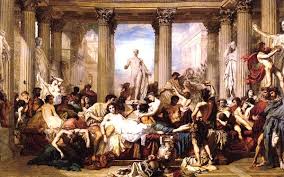A History of Valentine’s Day

January 31, 2017
It’s no big secret that the origins of Valentine’s Day are mostly secret. It’s been clouded up throughout the centuries, hidden by myths and tall tales. But here’s what we do know.
Valentine’s Day has it’s roots dug into the ancient Roman festival of Lupercalia. Lupercalia, being a primarily Pagan festival, was (you guessed it) a festival celebrating fertility. It was actually normally held on the 15th of February.
In about 496 A.D., the Pope at the time, Gelasius I, decided that this wasn’t cool. Fertility was so Ancient Civilization. Jesus was hip now. So, he recast the holiday as Valentine’s Day, to celebrate Saint Valentine. It was a day of feasting.
Here’s where it gets weird; there were at least three Saint Valentines prior to 496 A.D. One was a Roman Priest; another a Bishop in Tenri. The third, we know nothing about, except he died in Africa. The really, really creepy thing is they were all said to be martyred on February 14th.
Most scholars believe that one of these Valentines got on the bad side of Claudius II around 270 A.D.; this is all we know to be factual. The rest, is just a story. It’s said in one tale that Claudius had prohibited marriage for young men, but Valentine kept wedding couples. Soldiers caught up with him, and he was executed. Another says that Valentine was Claudius’ prisoner, and he fell in love with the Jailer’s daughter. Before he was executed, according to legend, he left her a letter signed “From Your Valentine”. The last, and most reasonable, story says that Valentine was executed for his love- his love of Christ. He had supposedly refused to repudiate his religion, and thus, got The Axe.
So V-Day wasn’t the lovey-dovey holiday we know it as today. It celebrated the Martyrdom of one of three men proclaimed Saints by the Catholic Church. In fact, it was never even remotely associated with romantic love until circa 14th century. Geoffrey Chaucer was the one who linked it to love in his “Parliament of the Fowls”. He had written it in celebration of the royal betrothal of Richard II of England and Anne of Bohemia. He linked it to the mating season of the fowls, the engagement, and Valentine’s Day, saying:
“For this was on Saint Valentine’s day,
When every fowl cometh there to choose his mate.”
Chaucer, being one of the most influential writers of the Middle Ages, obviously had, well, influence. From there on, the Holiday was associated with sex and romance once more, like it had been in the days of Ancient Rome and Lupercalia. By the 18th century, exchange of gifts and cards was custom on that day; it’s origin in martyrdom forgotten. Cards adorned with lace and ribbon spread to the American colonies, and merchants took hold of the holiday from henceforth.
In 1969, interesting enough, the Catholic Church took the holiday off it’s calender. It removed V-Day with other feasts celebrating Saints whose origins were unclear. We, of course, kept on. Barbara Park wrote Junie B. Jones and the Mushy-Gushy Valentine in 1999, which is how many of us really discovered the holiday.
And now, we pray for our own secret admirer, and the holiday will surely continue to evolve. Maybe one day we’ll call it something totally different, like, “Don’t-Kill-Your-Significant-Other-Because-They-Didn’t-Propose Day”.
That’s what I call it, anyways.















